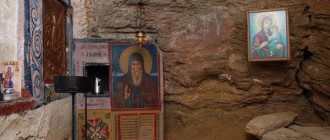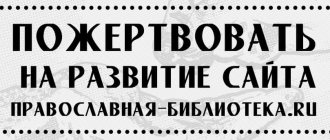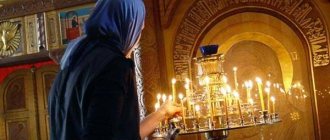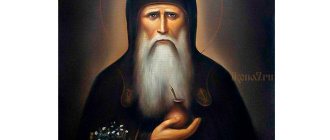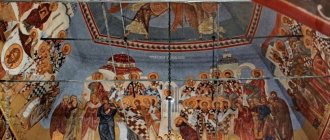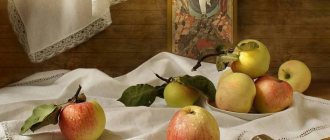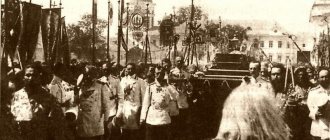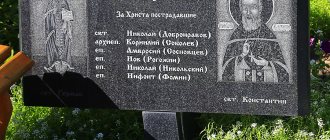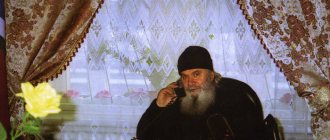Alypiy of Pechersk is an outstanding Orthodox icon painter who was canonized by the Russian Church. He is the first of the ancient Russian masters of painting, whose name became known to many Christians. The monk possessed rare spiritual gifts and became famous as a talented jeweler. The icons he created are considered miraculous, capable of helping people in the most difficult situations. The commemoration days of St. Alipius (Alympia, Olympia) are celebrated on August 17 and September 28.
Life path of a holy artist
The main source of information about Alipia of Pechersk is the “Tale of the first Russian icon painter Alympia,” included in the Kiev-Pechersk Patericon. The master's biography says that he was born around 1065 or 1070. His parents, whose names remained unknown, early noticed a talent for drawing in their son. At their request, young Alypius became a student of Greek masters and perfectly mastered the art of painting.
In his youth, an amazing miracle happened to Alypius: while an apprentice, he and other artists witnessed the appearance of the Most Pure Mother of God. This bright event took place when craftsmen decorated the altar of the Pechersk Church with paintings and mosaics. The face of the Virgin Mary shone with the brightest light, and from her lips a white dove flew out, which flew around the entire temple and flew into the mouth of the Savior.
The incident left an indelible mark on the heart of the young artist. When the work in the church was completed, Alypius became a monk. The painter was blessed to take the path of monasticism by the Venerable Abbot Nikon.
Alypiy devoted his subsequent life entirely to painting icons. In addition to drawing, the monk was engaged in the restoration of ancient religious images, which he treated with special trepidation. The saint surprised everyone around him with his unprecedented spirituality and selflessness, because:
- did not strive for fame and making money;
- he created all his masterpieces for the glory of the Lord;
- often worked for free.
What Alypius was given as payment, he never kept for himself. The saint divided the funds he earned into three parts: the first went to materials for creating icons, the second was given to the monastery needs, and he distributed the remaining funds to the poor.
When there were no orders for painting religious paintings, the master created for his own pleasure and distributed his works to believers. Alypius the icon painter worked every day and strictly observed all the fasts required of Christians. He stopped the process of creating sacred images only during prayer services.
Ivan Voronov grew up in the village, learned painting, made bombs at a factory
Ivan Mikhailovich Voronov was born in 1914 in the village of Torchikha.
An ordinary peasant family, not rich, but they had the opportunity to study in Moscow after rural school.
1914
year of birth of Ivan Mikhailovich Voronov
But Ivan Mikhailovich did not stay in the capital: his mother was ill in the village, and therefore his loving son returned to take care of her.
In 1932 he began studying at the evening studio at the Moscow Union of Artists. Ivan Mikhailovich liked this experience, so two years later he entered the art studio, whose status was approximately the same as the Academy of Arts.
Alypiy Pechersky
But service in the Red Army followed, where Ivan Mikhailovich did not give up his favorite job. He organized isocircles in military units of the Moscow Military District.
In 1938, Ivan Mikhailovich finished his service and became a dispatcher of the transport department at the military plant No. 58 named after. Voroshilov. Then it was a secret facility where bombs were made; today it is JSC Impulse.
This is where the Great Patriotic War found Ivan Voronov. The authorities tried to escape on official transport, but the future icon painter Alypius did not allow this. Vehicles were needed to deliver guns to the front. Ivan Mikhailovich did everything to ensure that everything happened exactly like this.
Ivan Voronov worked as a dispatcher at a military plant.
In the bustle of the war, Ivan Mikhailovich did not forget about his mother, and therefore took time to visit her. When he returned, there was no management left at the plant - only workers. Everyone together decided not to stop bomb production, although it was risky: Moscow was attacked by invaders.
The plant exceeded the standards three times. To do this, I had to sacrifice sleep, personal life, and actually live at the factory.
Miracles of Alypius of Pechersk
During his stay in the monastery, the Monk Alypius of Pechersk was for everyone around him an example of inner purity, kindness, and patience. Soon he was elevated from monk to priest. For his tireless spiritual exploits, the Lord showed mercy to Alypius and endowed him with the ability to heal the sick and bring people the light of truth.
Healing a leper
One rich resident of Kyiv could not recover from leprosy for a long time. One day he was advised to venerate the icons of the Pechersk Monastery, to which he, not being a deep believer, reluctantly agreed. When the patient was washed with holy water, his wounds opened and filled everything around with a stench.
The rich man took refuge in his house in fear, but after some time he returned to the monastery and repented of his sins. Here he managed to meet Alypius, who anointed the diseased areas of the body with his paints, and then advised him to take communion and wash himself with holy water. A real miracle immediately happened: the leprosy instantly receded, and the recovered Kiev resident happily returned home.
To express gratitude for Divine participation, Alypius ordered the recovered person to bring gifts to the Creator. Many years later, the great-grandson of this man also thanked for the miraculous healing by donating gold for the sacred ark.
Salvation of icons
There is a known case when two monks who knew Alypius decided to take advantage of his selflessness. One Christian donated silver to paint the icon, but these monks appropriated it and informed the customer that the master was allegedly asking for more money. The man fulfilled all the requirements, to which he received the answer that Alypiy refused to paint the picture.
After this, the Kiev resident turned to the abbot with a complaint. The monk was informed of what had happened. Alypius was incredibly surprised, since he knew nothing about this incident. The scammers had to reveal their insidious intent, after which they were expelled from the monastery.
In retaliation, the monks began to spread vile rumors about the holy icon painter, complaining that they themselves painted the images, and they were undeservedly punished. In this situation, the Lord himself came to the defense of Alipius. When there was a fire in Podol, the church with his works burned down, but seven icons were found without any damage.
Prince Vladimir Monomakh learned about how Alypiy was justified by God and protected from slanderers. The ruler arrived at the ashes and chose from the preserved images the icon of the Mother of God created by the monk, which he sent to the new Rostov church. Subsequently, this painting also fell into a blazing fire, but each time it remained completely unharmed.
Venerable Alypius, icon painter of Pechersk
Our venerable father Alypius, the icon painter of Pechersk, showed himself to be an imitator of the holy Evangelist Luke1, for he served the Lord, who created us in His image and likeness (Gen. 1:26), like Luke, namely: he not only miraculously depicted the faces of saints on icons, but and embodied their virtues in his soul; besides, he was a wonderful doctor; His pious life appears to us in this form: During the reign of the blessed prince of Kiev Vsevolod Yaroslavich2, under the abbot the Monk Nikon, according to the dispensation of God and on the advice of the venerable fathers Anthony and Theodosius3, who miraculously appeared in Constantinople in the tenth year after their repose, they arrived to decorate the saint Greek icon painters of the Pechersk Church; It was to these icon painters that Blessed Alypius was given by his parents to study the art of painting.
Reverend Alypius, icon painter of Pechersk Saint Alipius was an eyewitness to that wondrous miracle, which is narrated in the legend of the Pechersk church, namely: when the icon painters decorated the altar with painting, the
icon of the Most Holy Theotokos was depicted in it by itself : at the same time, this icon was illuminated and shone brighter than the sun: then From the mouth of the Most Holy Theotokos a dove flew out, which, after flying for a long time (through the church), flew into the mouth of the Savior, depicted on the icon located in the upper part of the church. It was then that this blessed Alypius studied, helping his teachers; and he also painted beautifully in his soul, for the grace of the Most Holy Spirit abided in that Pechersk church. When the aforementioned icon painters finished their work and decorated the holy church with icons, Alypius was also decorated by the Venerable Abbot Nikon with a miraculous image of the holy angelic monastic order. And Saint Alypius began to learn the art of depicting the virtues of saints in his soul, having already been trained in the art of depicting their faces materially (on icons). Saint Alypius was so skilled in his work that, by the grace of God, with a visible image on the icon he reproduced, as it were, the most spiritual image of the virtues; for he studied the art of icon painting not for the sake of acquiring wealth, but for the sake of acquiring virtues; he constantly worked, painting icons for the abbot, for the brethren and for all those in need, charging nothing for his work. Blessed Alypius asked everyone who saw dilapidated icons in any church to inform him about it; then, without demanding any remuneration, he decorated those churches with his art. If the saint was free from such work, then he practiced the art of icon painting for himself and painted icons, which he gave to those from whom he borrowed the gold and silver needed to decorate the icons. The saint did this in order not to spend time in idleness; He was likened to the ancient holy fathers, who were constantly engaged in handicrafts, and to the Supreme Apostle Paul himself, who says about himself: “These hands have served my needs and the needs of those who were with me (Acts 20:34). If, however, when Saint Alypius happened to earn any amount of money through his needlework, he divided it into three parts: the first part he spent on renovating icons, the second on alms to the poor, and the third he gave for monastic needs. This is what the saint did every year, giving himself no rest either day or night; for at night he practiced prayerful vigil and prostrations, while during the day he practiced handicrafts with great humility, non-covetousness, purity, patience, fasting, love, and contemplation of God; no one had ever seen him idle; but despite all this, he never missed prayer meetings, at least for his studies. Alipius the icon painter of Pechersk When the abbot noticed such great virtues and icon-painting art in the monk, so that he was worthy, wearing the angelic image of the monastic order, to be an imitator of the Son of God Jesus Christ - a Priest according to the order of Melchizedek5, he elevated him to the degree of priesthood. Then the monk was placed as a lamp on the candlestick (Matthew 5:15), or, better to say, as a role model in a high place, shining with the extreme beauty of monastic and priestly virtues; and the saint was not a simple example, for he worked miracles; Of his many miracles, we will recall here a few. One of the rich citizens of the city of Kyiv suffered from leprosy; This one sought help from many doctors, wizards and pagans, but not only did he not receive relief from his illness, but fell into an even worse state. Then one of the patient’s friends advised him to go to the Pechersk monastery to ask for prayer from the holy fathers; he agreed, but with displeasure. When this sick man was brought to the Pechersk monastery, the abbot ordered that he be given water from the saint’s well to drink, and also ordered that his face be washed with the same water. And immediately so much pus appeared on the sick man’s body, as a punishment for his lack of faith, that everyone shunned him, not being able to bear the foul smell emanating from the sick man’s body. Then, weeping and indignation, this leper returned to his house, and did not leave the house for many days, because of the stench emanating from him, saying to his friends: “They cover my face with dishonor.” I became a stranger to my brothers and a stranger to my mother’s sons (Ps. 68:8-9), because I did not show faith to the venerable fathers Anthony and Theodosius; and every day he expected his death. However, having come to his senses, this husband decided to confess all his sins; Therefore, he went again to the Pechersk monastery to the Monk Alypius and confessed his sins to him. The monk said to him: “You did well, child, that you came to confess your sins to God before my unworthiness; This is how the prophet testifies to himself, crying out to the Lord: “ I said: “I confess my crimes to the Lord,” and You took away from me the guilt of my sin (Ps. 31:5). Then the Monk Alypius taught him for a long time with soul-saving speeches, then, taking iconographic paints, he decorated his face, anointing the purulent places; After this, Saint Alypius led the sick man to church, communed him with the Divine Mysteries and commanded him to wash himself with the water with which the priests usually washed themselves after receiving the Holy Mysteries; Soon after this, the purulent scabs disappeared from the patient and he became healthy, as before. In this miracle-working, our venerable father Alypius revealed himself to be an imitator of our Lord Jesus Christ Himself; for just as Christ, healing a leper, commanded him to appear to the priest and bring a gift for his cleansing (Matthew 8:4), so this monk ordered the leprosy patient to appear to him as a priest during the priestly service, and to bring as a gift that What is the prophet talking about: “ What will I render to the Lord for all His good deeds to me? I will accept the cup of salvation (Ps. 116:3-4). Let us also mention here the gift, for the great-grandson of this leper, in gratitude for his cleansing, bound the ark in gold, which was located above the holy altar in the Pechersk church. In addition, the Monk Alypius revealed himself to be an imitator of Christ, who healed the man born blind; for, just as Christ, healing a man born blind, first anointed his eyes with clay, then commanded him to wash himself in the font of Siloam (which means “sent”) (John 9:6-7), so this saint first anointed the scabs of the leper with iconographic paints, then ordered him to wash himself with the water with which priests, the messengers of God, usually wash themselves; In this way, the saint healed the sick man both from physical leprosy and from sinful blindness, so that everyone who came from the city with the sick man was greatly amazed at such a quick healing. But the Monk Alypius said to them: “Brothers!” Notice what it says: “ No one can serve two masters (Matt. 6:24); for this man was originally enslaved to the demon because of his sins; therefore, when he came to God, but on the advice of the enemy, he despaired of his salvation and did not believe in the Lord, Who alone could save him, then leprosy took hold of his body with even greater force, as punishment for his unbelief; for the Lord said: “ Ask , and not just “ ask ,” but in faith, “ it will be given to you (Matthew 7:7). When now he turned to God a second time with repentance, in my presence, then “ God, rich in mercy (Eph. 2:4), healed him. Having heard this, the people bowed to the saint and set off on the return journey together with the healed man, glorifying God and the venerable fathers Anthony and Theodosius, as well as their disciple, our venerable father Alypius; and they said about this holy Alipias that he was revealed to them as a new Elisha, for he healed that sick man of leprosy, just as Elisha healed Naaman the Syrian of leprosy (2 Kings 5:14). There was also someone from the same city of Kyiv, a pious man. This one built a church and wished to have seven large icons to decorate the church; this man gave the silver, along with the boards intended for drawing icons, to two monks of the Pechersk monastery, familiar to him, asking them to consult with Saint Alypius regarding the writing of icons. But the monks did not say anything to Alypius, and appropriated the silver for themselves. After some time, that husband sent to ask the monks whether his icons were painted or not? They replied that Alypius demanded more silver. Then again, taking the silver sent from that husband, they appropriated it for themselves. Then, reaching the extreme of shamelessness, these two monks again sent to tell that husband (slander of the saint) that Alypius demanded as much silver as he had received. The Christ-loving man gave the silver a third time, saying: “I greatly desire to receive prayer and blessing from the work of his hands.” Saint Alypius knew nothing about what the monks were doing. Finally, the husband sent again to find out for sure whether the icons had already been painted? The monks, not knowing what to answer, said that Alypius took all the silver sent three times, but did not want to paint icons. Then that Christ-loving husband arrived at the Pechersk monastery along with his retinue, went to Abbot Nikon and told him about the reason for the sadness inflicted on him (allegedly) by Alypius. The abbot, calling Alypius, said to him: “Why are you, brother, inflicting such an insult on this son of ours, who very much begged you to paint icons and gave you the amount of silver you asked for?” But you, having taken so much silver and made a promise to paint icons, did not paint them, although in other cases you painted icons without any payment. Blessed Alypius answered this: “Honest father!” You know well that I have never shown laziness in this matter; but now I have absolutely no idea what you are talking about. Then the abbot said to him again: “You took triple the price for painting seven icons; but you haven't written them yet. And immediately, wanting to expose the saint, he ordered to bring boards intended for painting icons (those boards the day before were seen standing in one of the monastery buildings, and nothing was depicted on them): the abbot also ordered to call those monks, through whom This husband handed over the silver to the saint, so that these monks would expose Alypius. Alypius the icon painter Those sent for the boards found them very skillfully painted and brought them to the abbot. Seeing this, everyone who was there was very surprised and fell into great fear; then, with trepidation, they fell prostrate to the ground and worshiped those images not created by the hand of man - namely, the image of the Lord, the image of the Most Holy Theotokos and other images of the saints of God. Then those two monks came who slandered Alypius; not knowing anything about this miracle, they entered into an argument with the saint, saying: “You took triple the price, but you don’t want to paint icons!” Hearing these words, everyone who was there showed the icons to those monks, saying: “These icons, written by God Himself, certify the innocence of Alypius!” Those monks, seeing the icons, were horrified by such a great miracle. They were immediately convicted by the abbot of theft and lies, were expelled from the monastery and deprived of all their property. But these monks did not stop their malice: they began to spread blasphemy against the Monk Alypius in the city, claiming that they themselves had painted those icons; “Our boss,” they said, “not wanting to reward us for our work, in order to remove us from work, lied about the icons, that they were painted by God Himself, who wanted to justify Alypius. Hearing such speeches, many citizens went from the city to the monastery in order to see those icons and venerate them. However, despite the fact that many of the citizens believed those monks who slandered the Monk Alypius, God glorifies His saints, as He Himself says in the Holy Gospel: “ a city standing on the top of a mountain cannot hide (Matthew 5:14 ); and again: “ Having lit a candle, they do not put it under a bushel, but on a candlestick, and it gives light to everyone in the house (Matthew 5:15) - God did not hide the virtuous deeds of this righteous man; for the news of this miracle performed by the Lord for the sake of Saint Alypius reached Prince Vladimir Monomakh himself; this miracle was also confirmed in the following way: By God’s permission, a fire broke out in Kyiv, from which almost the entire Podol8 in Kyiv burned down; in this part of the city there was also a church with the mentioned icons, which also burned down; however, after the fire they found all those icons completely intact. When the prince heard about this, he personally came to the place of the fire, wanting to see the miracle that took place there. Seeing the icons that remained unharmed by the fire, the prince first of all learned that they were painted in one night according to the dispensation of God, who wanted to justify Alypius from the slander that had been leveled against him. Then Prince Vladimir Monomakh zealously glorified the Creator of all Boa, who performed such great miracles for the sake of the virtues of the Monk Alypius. Then, taking one of those icons, namely the icon of the Most Holy Theotokos, he ordered it to be sent to the city of Rostov, to the stone church that was located there, built by him. This church in Rostov was once destroyed, but the icon remained completely undamaged. Then the icon was placed in a wooden church; but this church, after some time, burned down from a fire; The icon again remained undamaged, so that there was not even a small scratch on it after the fire. All this undoubtedly confirmed the virtuous life of our venerable father Alypius, for whose sake that icon was painted by itself. Let us now move on to the miracle that took place at the death of the saint, in order to see how marvelously this man, a skilled creator of icons, passed from this temporary life to eternal life. A certain pious man asked our venerable father Alypius to paint an icon of the Most Holy Theotokos; On this occasion, he asked the saint to paint this icon for the day of the Feast of the Dormition. But the monk fell ill soon and was already approaching his death; and the icon, meanwhile, was not painted; That man was very sorrowful over this incident and greatly disturbed the saint. Blessed Alypius said to him: “Child!” Don’t bother me, but cast all your sorrow on the Lord, and He will do as He wishes: the icon will be in its place on His holiday. That husband, believing the words of the saint, went to his house with joy. Then he again came to Alypius on the eve of the Feast of the Dormition of the Blessed Virgin Mary. Seeing that the icon was not painted. Seeing also that the Monk Alypius became even more ill, that husband began to reproach the blessed one, saying: “Why didn’t you tell me anything about your serious illness?” Then I would give the icon to another icon painter, who would paint it for me, so that the holiday would be honest and solemn; but now you plunge me into great shame. The monk answered him with meekness: “Oh child!” Did I do this out of laziness? However, God can write an icon of His Mother with a single word; Now I myself am leaving this world, as the Lord revealed this to me, but I don’t want to leave you in sadness. That husband passed away in deep sorrow. Immediately after his departure, a certain bright young man went to the Monk Alypius, who began to paint an icon for that husband. Alypius thought that the man, offended by him, had sent a new icon painter, and at first mistook that young man for a man; however, the speed and grace of his work showed that something was an angel; for in the course of three hours he painted a very beautiful icon, now putting gold on the icon, now rubbing various colors on stone and painting with them; then he said to the monk: “Father!” Perhaps there is still something missing here, or have I made a mistake? The monk answered: “You did everything perfectly; God Himself helped you paint the icon with such splendor; He Himself did this through you. When evening came, that icon painter and the icon became invisible. Meanwhile, the owner of the icon could not sleep all night from sadness, because he thought that the icon would not be ready for the holiday; therefore, he considered himself unworthy of such mercy of God and called himself a great sinner. For this reason, getting up in the morning, the next day, he went to church in order to confess his sins to the Lord there. But as soon as he opened the doors of the temple, he saw the icon standing in its place. He immediately fell to the ground in fear, thinking that it was a ghost: then, rising a little from the ground, and looking attentively at the icon, he realized that it was his icon. As a result of this, he came into great fear and horror and remembered the words of the Monk Alypius, who told him that the icon would be ready for its feast; then he went and woke up all his household. His family hurried joyfully to the temple with candles and censers; Seeing here an icon shining like the sun, everyone fell to the ground, bowed to the icon and kissed it with a joyful soul. After this, that pious man went to the abbot and told him about the miracle that happened to the icon; Then they went together to the Monk Alypius and found him already departing from this world. Despite this, the abbot asked him: “Father!” By whom and how was the icon painted for this husband? Alypius told them everything he had seen and said: “An angel wrote that icon, and he is standing here intending to take my soul.” Having said this, the blessed one gave up his spirit into the hands of the Lord on the seventeenth day of the month of August9. The brothers covered his body with swaddling clothes and carried him to the church; then, having performed the usual funeral chants, they laid the body of the saint in the cave of the Monk Anthony. This is how this holy miraculous icon painter decorated heaven and earth; having lived on earth in body, he ascended to heaven with a virtuous soul, to glorify the Chief of icon painters, God the Father, Who said: “ Let us make man in Our image [and] in Our likeness (Gen. 1:26), and also in the “ image of His hypostasis” (Heb. 1:3), God the Son, who became in appearance as a man (Phil. 2:7);
Together with the Holy Spirit, who went from the sky in the image of a dove (Matthew 3:16) and the form of fiery languages (Acts 2: 3). All the God, the God of the Father, the God of the Son and the God of the Holy Spirit, who are in a single being, we will praise with our alipius and we will glorify in the endless eyelids. Amen. 1 St. Luke-an apostle of 70, a writer of the third gospel and books of the Acts of the Apostolsky, satellite and employee of St. Apostle Paul. St. Luke was from the Antioch of Syrian; He was a doctor how to talk about this AP. Pavel to the message to the Kolossyans (4:14) and the painter, according to the testimony of Philostorgia and Nikifor Callista. According to legend, he wrote the icon of the Mother of God. He died of 80 years in the Theotheian Thebes. His relics in 360 were transferred to Constantinople. - His memory is performed by St. Church on October 18. 2 Vsevolod Yaroslavich reigned for the first time from 1075 to 1076 (six months) and in the second-from 1078 to 1093. 3 Rev. Anthony and Theodosius-the founders of the Kiev Pechersk Lavra. Memory of St. Anthony is celebrated by St. Church on July 10, and St. Feodosia - May 3. Anthony and Theodosius Together - September 2 according to the station. 4 of his life cm under June 29. 5 Melchizedek, the king of Salimsky, the priest of the God of the High, is mentioned in the book of Genesis (14:18). The book of Genesis, telling about Melchizedek, does not say anything about the origin of Melchizedek, or about the end of his life, which, along with the blessing of Abraham, made Melchizedek, according to the explanation of St. The Apostle Paul (Heb. 6:20) by the prototype of Jesus Christ, the eternal high priest and the king. Tsar and Prophet David, when he spoke of the Son of God, also pointed to the priesthood of the priesthood of Melchizedekov: “You are the priest on the rank of Melchizedek” (Psalm 109: 4). But the pro -formal value of Melchizedek in St. Apostle Paul, in a message to Jews (7 ch.). 6 Elisha - the Prophet Israeli memory is celebrated by St. Church on June 14. 7 Vladimir Monomakh Princess from 1114 to 1125. 8 part of the city. 9 The death of the Monk Alipia followed in 1114 (43)
Share:
Repose of the Reverend
Before leaving for another world, Alipius was shown another amazing miracle. Shortly before his death, the master undertook to complete an order to paint an icon of the Mother of God. The monk promised to do the work before the Dormition of the Mother of God, but he soon weakened and fell ill. Despite his serious condition, he was very worried about fulfilling his promise and not letting the customer down.
The Lord, who heard the hopes and prayers of the holy artist, sent him a bright angel to help him. The legend tells that a beautiful young man appeared before the dying Alipius, who in a few hours completely completed the image of the Queen of Heaven.
The person who ordered the icon was overjoyed and sincerely thanked for the incredibly beautiful painting. After these events, the Monk Alypius of Pechersk rested peacefully. The date of his death is considered to be August 1114. The saint's body was buried in the nearby (Antoniev) caves. The relics of the icon painter remain here to this day.
As governor, Father Alypiy defended the Pskov-Pechersk Monastery from attacks by Soviet power
In the Trinity-Sergius Lavra, everything did not immediately work out well. The governor said that he could not allocate a separate cell, but if the monk himself built something in the corridor overnight, he could live there.
Father Alypiy successfully completed the task, which surprised the abbot. He clearly did not count on the monk’s success. However, Alipi's father succeeded: partitions, plaster, flooring, even a samovar.
Psokovo-Pecherky Monastery, where Father Alypiy served as governor
Already in 1959, Father Alypiy became the abbot of the Pskov-Pechersky Monastery - the second of two operating in the USSR. It was a difficult time.
The Soviet authorities tried to close the Pechersky Monastery. In addition, there were internal concerns. For example, Father Alipius intended to restore ancient shrines.
During the years of Father Alypius' governorship, only 2 monasteries operated in the USSR.
But how to manage everything? How to deal with everything?
Khrushchev's government put serious pressure on the Church. There was active propaganda in the newspapers. The headlines were intensifying, turning people against the monastery. Corrupt and simply enslaved journalists willingly practiced witticisms against the “priests” and reproached them for obscurantism.
But there was hope! After the war, the position of the Orthodox Church strengthened, but no, the country was recovering, and the clergy again became “freeloaders.” Arrests, slander, threats, etc. were used. It was simply becoming difficult to live, because every monk and priest was losing the chance to secure a life for themselves.
But Father Alypiy was not afraid and boldly responded to the attacks. No one could defeat him in controversy. For example, they tell the following story. Financial workers came to the monastery to conduct an inspection.
“Who authorized you?
- We have been empowered by the people!
“Then at tomorrow’s service we will ask you to go to the pulpit and ask the people whether they authorized you.”
- We have been authorized by the party!
— How many people are in your party?
- 20 million.
— And in our Church there are 50 million. The minority cannot dictate to the majority.”
Another time, the same inspectors returned with an order, but Father Alypiy Pechersky said that he could only authorize an inspection with the blessing of the diocese. The inspectors called the diocese and received a blessing.
“Are you communists?
How about you communists?
could they take a blessing from a clergyman?
I'll call the regional party committee now,
you will be expelled from the party tomorrow.”
Alipiy Voronov
archimandrite
These inspectors did not visit the monastery again. There were others, but either they posted a notice about the plague at the monastery, or they managed to come up with something else.
Father Alypiy was actively involved in the restoration of the monastery and churches
Father Alypiy did not forget about his goal - the restoration of the heritage of the Orthodox Church.
Until 1968, he returned the following to a usable form:
- walls of the Pskov-Pechersky Monastery;
- prison tower;
- Assumption Church;
- Sretensky Church;
- Pokrovsky Church;
- abbot's house;
- fraternal corps;
- Tararygina tower;
- Izborsk Tower;
- Annunciation Tower;
- Peter's Tower;
- pavements in the monastery;
- bridge to the Assumption site;
- Nikolskaya Tower;
- beds and tunnel of the Kamenets stream.
The Izborsk Tower is one of the objects that was restored by Alypiy of Pechora.
Father Alypy also set up an icon-painting class, rebuilt the stove, repaired the Lazarevsky Church, restored the iconostasis of the Assumption Church, St. Nicholas Church, St. Michael's Cathedral. This is not a complete list of everything that Father Alypiy managed to do.
